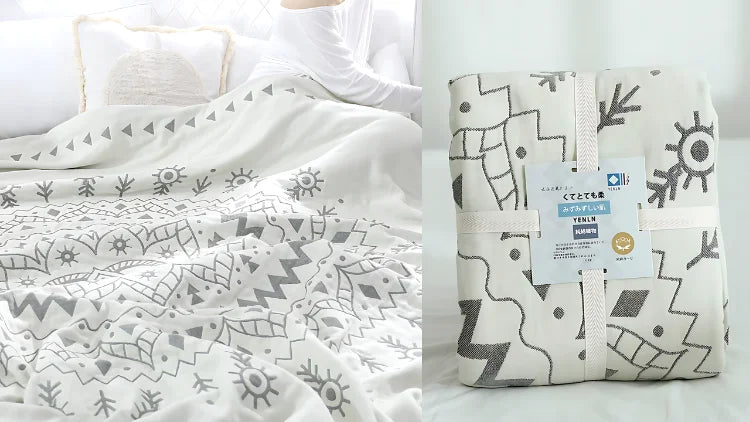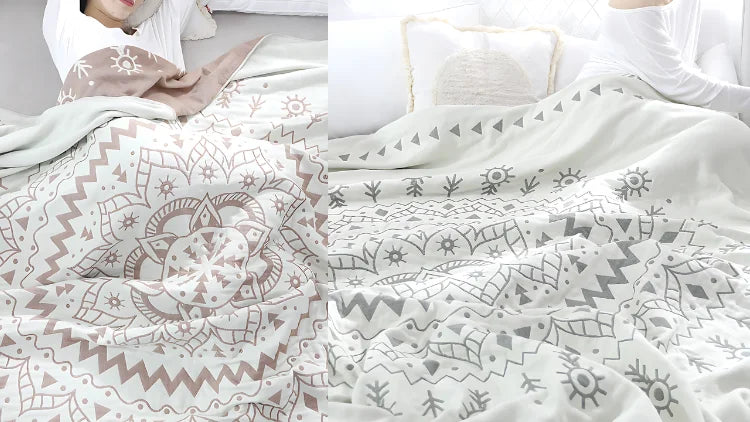While all three - quilts, comforters, and duvets - aim to provide warmth and comfort to sleepers, they do so in different ways. For example, a duvet typically combines a separate insert and cover, while a comforter integrates the cover into its design. Conversely, a quilt has an insulating layer sandwiched between two layers of fabric.
What is a Quilt?

The quilt, with its unique three-layer design, is meticulously crafted for both beauty and practicality, much like quilts and coverlets that serve similar purposes in home decor. The top layer consists of selected pieces of fabric, which can range from soft cotton to ruggedly textured linen, that have been skillfully arranged in a variety of patterns, reflecting the quilter's skillful hands and creativity.
The middle or insulating layer is usually filled with materials such as cotton, wool, modern synthetic fibers, or cotton batting to provide the necessary warmth for the quilt. They are available in a variety of densities, including 2, 3, 6, and 8 layers.
The back layer of the quilt is relatively simple in design and is intended to balance out the intricate patterns of the top layer, sometimes presented in a single color and sometimes in a more subtle pattern that echoes the top layer.
Materials Commonly Used in Quilts
When it comes to quilts, the materials used are as diverse as the patterns and designs they form. Each choice of fabric and filling brings unique qualities to the quilt, influencing not only its appearance but also its warmth, weight, and how it drapes over your bed.
Top Layer Fabrics:
- Cotton: A go-to for its softness and breathability, cotton fabric makes quilts comfortable for year-round use. Its versatility allows for a wide range of colors and patterns.
- Linen: Known for its strength and luxurious feel, linen adds an elegant touch to quilts. It's highly breathable, making it perfect for warmer climates.
- Silk: For a dose of opulence, silk quilts are unmatched. They offer a smooth, lustrous surface that elevates bedroom decor.
Middle Layer (Batting):
- Cotton Batting: Offers a comfortable, natural feel and is preferred for its softness and breathability. It provides moderate warmth, suitable for many climates.
- Wool Batting: Wool is excellent for colder months, thanks to its natural ability to regulate temperature. It's heavier than cotton but extremely warm.
- Polyester Batting: A more affordable option, polyester provides lightweight yet warm batting. It's less breathable than natural options but holds its shape well over time.
- Cotton Yarn: Moisture Absorbent: Cotton yarn itself has a soft texture that is gentle on the skin and less likely to irritate. The cotton yarn has good moisture absorption and breathability, which helps to reduce overheating and sweat accumulation.
Backing Fabrics:
- Broadcloth: A popular choice for the quilt back, broadcloth is a densely woven cotton fabric that's both durable and soft.
- Muslin: For those preferring a lighter weight, muslin is a finely woven cotton that's soft to the touch and allows the quilt to drape beautifully.
- Flannel: To add an extra layer of warmth, flannel backing is cozy and soft, perfect for snuggling under on cold nights.
Stitching Threads:
- Cotton Thread: Widely used for its strength and color variety, cotton thread blends seamlessly with most quilting fabrics.
- Polyester Thread: Known for its durability and flexibility, polyester thread is great for quilts that will see a lot of wear and washing.
You can come to Ownkoti's website to take a look at the quilts, we have three main types of quilts: cotton quilts, bamboo quilts, and baby quilts, in addition to other products such as quilt coverlets, blankets, and so on, so come and take a look!
Pros and Cons of Quilts
|
Pros |
Cons |
| Provides warmth |
May not offer as much insulation as comforters or duvets |
|
Versatile |
Thinner and flatter than other bedding options |
|
Adds aesthetic appeal |
Washing and maintenance requirements may vary |
|
Can be decorative |
Some quilts may be delicate and require special care |
|
Durable |
The price range varies, with some options more expensive |
|
Offers reversible design |
Limited options for changing style or color |
|
Suitable for all seasons |
What is a Comforter?

A comforter is more than just a layer of fabric and filling. Comforters are crafted with meticulous attention to detail and typically consist of two layers of fabric sewn together to create a durable outer shell. This shell encloses a luxurious filling, which can range from sumptuous down to a hypoallergenic alternative like cotton or wool. Inside the comforter, you'll find carefully crafted chambers or pockets that hold the filling, ensuring it remains evenly distributed throughout the comforter. This thoughtful design prevents the filling from shifting or bunching up, ensuring consistent warmth and eliminating any bothersome cold spots that might disrupt sleep.
Pros and Cons of Comforter
|
Pros |
Cons |
|
Single, ready-to-use piece without the need for additional covers. |
Can be bulky, taking up significant space in the wash. |
|
Provides a cozy layer, suitable for various climates. |
Can't change covers; updating the look means buying a new comforter. |
|
Wide array of colors, patterns, and materials to match decor and style. |
Set warmth level, might need extra blankets or lighter sheets for seasonal changes. |
|
Often sold in sets for a coordinated look. |
Filling can clump or flatten over time, affecting look and warmth. |
|
Many are machine washable for easy cleaning. |
High-quality options, especially down-filled, can be expensive. |
What is a Duvet?
The duvet core can be filled with luxuriously fluffy down or with equally comfortable but hypoallergenic synthetic fibers, providing options for all types of sleepers.
Not only do duvets provide warmth, they can also be quickly changed with an easy-to-change cover.
Designed with easy-to-use closures such as zippers or buttons, duvet covers are easy to clean. With a duvet cover, clean, fresh bedding is at your fingertips with little effort. The smooth, uncluttered look of a duvet cover provides a canvas for creativity, allowing texture, color and pattern to play a role in the bedroom aesthetic.
Pros and Cons of Duvet
|
Pros |
Cons |
|
Easy decor changes |
Can be expensive |
|
Washable cover |
Frequent changes needed |
|
Cozy with adjustable warmth |
May cause uneven warmth |
|
Quick to tidy |
Finding the right cover size is tricky |
|
Hypoallergenic options |
Might need extra blankets |
Quilt vs. Comforter vs. Duvet
Quilts, comforters, and duvets all offer warmth and comfort to sleepers, but there are key differences that may make one option preferable over another for each individual.
Quilts often feature decorative patterns or designs stitched into their top layer, and they may also be pieced together. They tend to be thinner and flatter than comforters or duvets, though this depends on the materials used to make them. Many quilts boast a reversible design, meaning either side can be used, making them a great choice for those who like to rotate bedding.
Comforters and duvets are often confused, but the main distinction lies in the fact that duvets are designed to be used with a duvet cover, while comforters can be used without one.
Duvet covers can help protect the duvet insert from getting dirty, thus extending its lifespan and providing a warmer bed covering. However, comforters are typically easier to clean and are suitable for warmer climates or those who prefer cooler sleep.
|
Category |
Quilts |
Comforters |
Duvets |
|
Durability |
Machine-made: high; Hand-sewn: low |
Moderate; filling may flatten |
High with protective covers |
|
Warmth & Loft |
Light materials, suitable for warmer months |
Thicker, less breathable |
Highest loft, ideal for cold weather |
|
Cost |
Varied; machine-made cheaper than hand-sewn |
Varies by materials |
Generally higher, varies by materials |
|
Style |
Wide range from traditional to modern |
Various styles and colors |
Covers offer style flexibility |
|
Cleaning & Maintenance |
Machine-made: easy; Hand-sewn: needs care |
Needs careful maintenance |
Less frequent; covers washable separately |
|
Seasonal Needs |
Ideal for summer |
Mid-level warmth; may need extra in winter |
Great for winter; too warm for summer |
Which Should You Choose?
Choosing between quilts, comforters, and duvets depends on your personal preferences, sleeping habits, and specific needs. Here are some factors to consider when making your decision:
- Warmth Preference: If you prefer lightweight bedding that is suitable for warmer months, a quilt may be the best option. For those who desire more warmth and coziness, especially during colder seasons, a comforter or duvet would be more appropriate.
- Durability: Consider how often you plan to wash your bedding and the level of care you're willing to provide. Machine-made quilts are generally more durable and easier to maintain, while hand-sewn quilts may require extra care. Comforters and duvets can last a long time with proper care, but comforter fillings may flatten over time.
- Style and Aesthetics: Quilts offer a wide range of styles, patterns, and colors, making them versatile for various bedroom décors. Comforters and duvets also come in diverse styles, but changing the aesthetics of your bedding may require purchasing a new comforter or duvet cover.
- Budget: Consider your budget and the cost of each bedding option. Quilts, especially machine-made ones, may offer a more affordable option compared to comforters and duvets. However, the price can vary depending on the quality of materials and craftsmanship.
- Cleaning and Maintenance: Think about your cleaning preferences and lifestyle. Quilts and duvets with removable covers are generally easier to clean, while comforters may require more care, especially if they have delicate fillings.
- Seasonal Needs: Take into account the climate of your area and your comfort preferences throughout the year. Quilts are suitable for warmer months, while comforters and duvets provide more warmth and insulation, making them ideal for colder seasons.
Conclusion
Quilts offer versatility, style, and lightweight warmth, making them ideal for warmer seasons or for those who prefer a cooler sleeping environment. Comforters offer moderate warmth and come in a variety of styles and colors, but may require more maintenance to keep the fill from flattening out over time. Down comforters offer the highest level of loft and warmth, are perfect for cold weather, and can be easily customized with interchangeable duvet covers.
In conclusion, it is important to weigh the various factors discussed in this comparison guide when choosing a quilt, duvet cover, and duvet. Your choice should reflect your preferences, sleeping habits, budget, and lifestyle.


